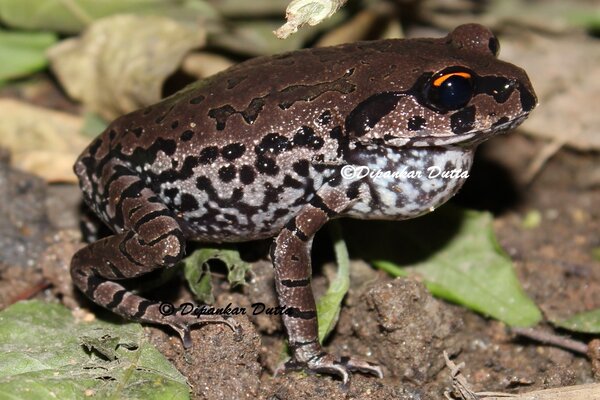
In a significant breakthrough for biodiversity research in Northeast India, a new species of frog has been identified from the Garbhanga Reserve Forest in Western Assam and the adjoining Ri-Bhoi District of Meghalaya.
The discovery was made by Dr. Dipankar Dutta, Assistant Professor, Department of Zoology, University of Science & Technology Meghalaya (USTM), in collaboration with eminent herpetologists Dr. Jayaditya Purkayastha, Dr. Jayanta Gogoi, and Dr. Saibal Sengupta.
Published in the internationally renowned journal Zootaxa on April 14, the newly described species—Leptobrachium aryatium—adds a crucial piece to the puzzle of amphibian diversity in the region. The frog exhibits unique morphological characteristics that set it apart from its congeners, contributing to a deeper understanding of speciation and evolutionary significance in this group of amphibians.
The discovery also brings attention to the ecological richness of the region, highlighting the urgent need to preserve these fragile ecosystems through sustained conservation efforts and further scientific exploration. What makes this finding especially meaningful is the naming of the species. The researchers have paid homage to their alma mater—Arya Vidyapeeth College (Autonomous), Guwahati—by naming the species Leptobrachium aryatium.
The Herpetology Laboratory of Arya Vidyapeeth College has been instrumental in advancing amphibian research and enjoys national and international recognition. Each member of the research team has, at some point, been associated with the college either as students or faculty members.
Speaking on the occasion, Dr. Dipankar Dutta shared, “This species was first reported in 2001 by my mentor and guide as Leptobrachium smithi—marking the very first report of this genus from India. After completing my Master’s, it was my guide Dr. Saibal Sengupta who encouraged me to pursue further research on this species for my PhD, as nothing was known about its biology at the time. Over the years, we carried out extensive studies on its taxonomy, breeding and reproductive biology, life cycle, feeding habits, acoustic patterns, home range, and molecular phylogeny. This comprehensive research ultimately led us to nominate it as a new species—and what could be more fitting than naming it after Arya Vidyapeeth College, where it all began. I am also deeply grateful to the University of Science and Technology Meghalaya for providing all the necessary support and logistics during my time there, which made this achievement possible.”
The research on this frog species began as early as 2004 and identifies it as previously considered part of the Leptobrachium smithi group, which is also found in Southeast Asian countries.